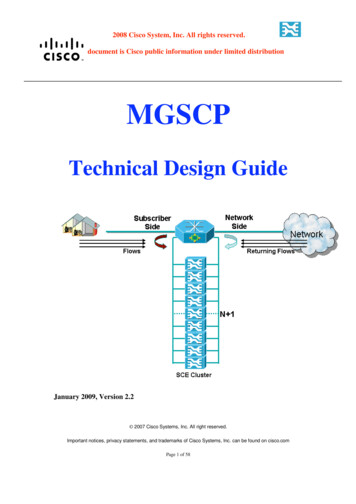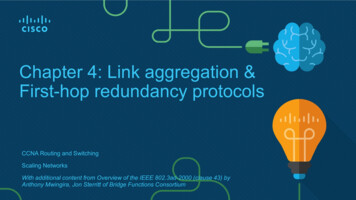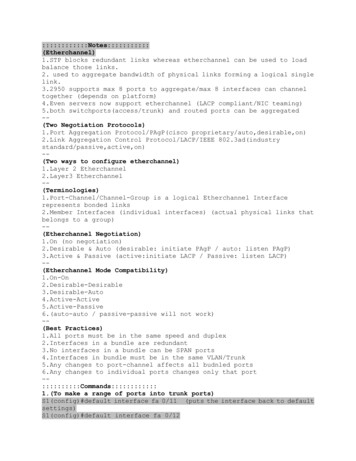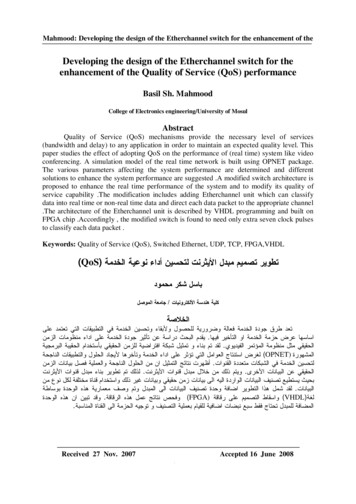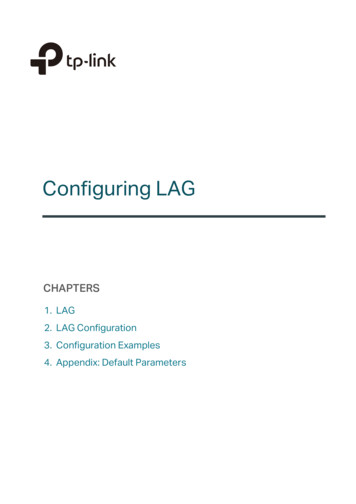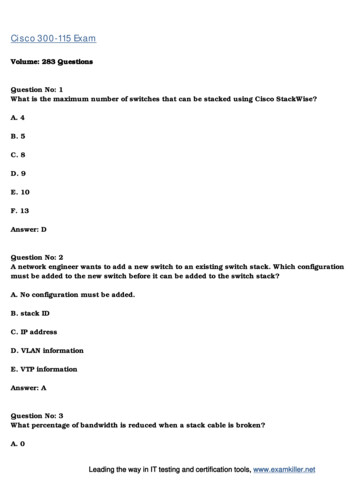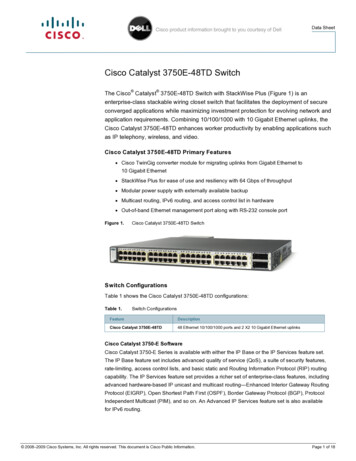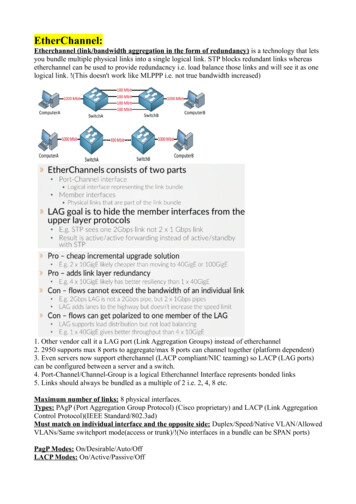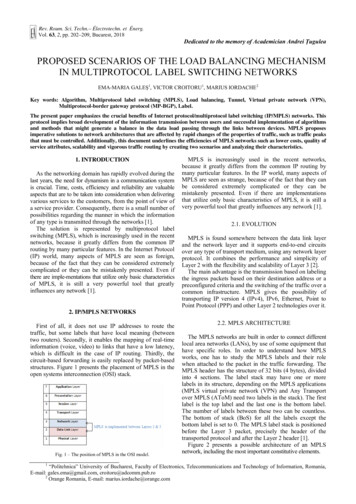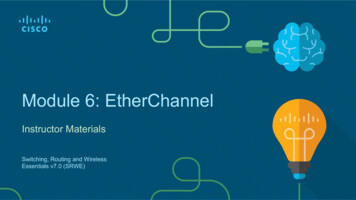
Transcription
Module 6: EtherChannelInstructor MaterialsSwitching, Routing and WirelessEssentials v7.0 (SRWE)
Module 6: EtherChannelSwitching, Routing and WirelessEssentials v7.0 (SRWE)
Module ObjectivesModule Title: EtherChannelModule Objective: Troubleshoot EtherChannel on switched links.Topic TitleTopic ObjectiveEtherChannel OperationDescribe EtherChannel technology.Configure EtherChannelConfigure EtherChannel.Verify and TroubleshootEtherChannelTroubleshoot EtherChannel. 2016 Cisco and/or its affiliates. All rights reserved. Cisco Confidential10
6.1 EtherChannel Operation 2016 Cisco and/or its affiliates. All rights reserved. Cisco Confidential11
EtherChannel OperationLink Aggregation There are scenarios in which more bandwidth or redundancy between devices isneeded than what can be provided by a single link. Multiple links could be connectedbetween devices to increase bandwidth. However, Spanning Tree Protocol (STP),which is enabled on Layer 2 devices like Cisco switches by default, will blockredundant links to prevent switching loops.A link aggregation technology is needed that allows redundant links between devicesthat will not be blocked by STP. That technology is known as EtherChannel.EtherChannel is a link aggregation technology that groups multiple physical Ethernetlinks together into one single logical link. It is used to provide fault-tolerance, loadsharing, increased bandwidth, and redundancy between switches, routers, andservers.EtherChannel technology makes it possible to combine the number of physical linksbetween the switches to increase the overall speed of switch-to-switchcommunication. 2016 Cisco and/or its affiliates. All rights reserved. Cisco Confidential12
EtherChannel OperationEtherChannelEtherChannel technology wasoriginally developed by Cisco as aLAN switch-to-switch technique ofgrouping several Fast Ethernet orGigabit Ethernet ports into onelogical channel.When an EtherChannel isconfigured, the resulting virtualinterface is called a port channel.The physical interfaces arebundled together into a portchannel interface, as shown in thefigure. 2016 Cisco and/or its affiliates. All rights reserved. Cisco Confidential13
EtherChannel OperationAdvantages of EtherChannelEtherChannel technology has many advantages, including the following: Most configuration tasks can be done on the EtherChannel interface instead of on eachindividual port, ensuring configuration consistency throughout the links. EtherChannel relies on existing switch ports. There is no need to upgrade the link to a fasterand more expensive connection to have more bandwidth. Load balancing takes place between links that are part of the same EtherChannel. EtherChannel creates an aggregation that is seen as one logical link. When severalEtherChannel bundles exist between two switches, STP may block one of the bundles toprevent switching loops. When STP blocks one of the redundant links, it blocks the entireEtherChannel. This blocks all the ports belonging to that EtherChannel link. Where there is onlyone EtherChannel link, all physical links in the EtherChannel are active because STP sees onlyone (logical) link. EtherChannel provides redundancy because the overall link is seen as one logical connection.Additionally, the loss of one physical link within the channel does not create a change in thetopology. 2016 Cisco and/or its affiliates. All rights reserved. Cisco Confidential14
EtherChannel OperationImplementation RestrictionsEtherChannel has certain implementation restrictions, including the following: Interface types cannot be mixed. For example, Fast Ethernet and Gigabit Ethernetcannot be mixed within a single EtherChannel. Currently each EtherChannel can consist of up to eight compatibly-configuredEthernet ports. EtherChannel provides full-duplex bandwidth up to 800 Mbps (FastEtherChannel) or 8 Gbps (Gigabit EtherChannel) between one switch and anotherswitch or host. The Cisco Catalyst 2960 Layer 2 switch currently supports up to six EtherChannels. The individual EtherChannel group member port configuration must be consistent onboth devices. If the physical ports of one side are configured as trunks, the physicalports of the other side must also be configured as trunks within the same nativeVLAN. Additionally, all ports in each EtherChannel link must be configured as Layer 2ports.Each EtherChannel has a logical port channel interface. A configuration applied to theport channel interface affects all physical interfaces that are assigned to that interface. 2016 Cisco and/or its affiliates. All rights reserved. Cisco Confidential15
EtherChannel OperationAutoNegotiation ProtocolsEtherChannels can be formed through negotiation using one of two protocols, PortAggregation Protocol (PAgP) or Link Aggregation Control Protocol (LACP). Theseprotocols allow ports with similar characteristics to form a channel through dynamicnegotiation with adjoining switches.Note: It is also possible to configure a static or unconditional EtherChannel without PAgPor LACP. 2016 Cisco and/or its affiliates. All rights reserved. Cisco Confidential16
EtherChannel OperationPAgP OperationPAgP (pronounced “Pag - P”) is a Cisco-proprietary protocol that aids in the automatic creation ofEtherChannel links. When an EtherChannel link is configured using PAgP, PAgP packets are sentbetween EtherChannel-capable ports to negotiate the forming of a channel. When PAgP identifiesmatched Ethernet links, it groups the links into an EtherChannel. The EtherChannel is then added tothe spanning tree as a single port.When enabled, PAgP also manages the EtherChannel. PAgP packets are sent every 30 seconds.PAgP checks for configuration consistency and manages link additions and failures between twoswitches. It ensures that when an EtherChannel is created, all ports have the same type ofconfiguration.Note: In EtherChannel, it is mandatory that all ports have the same speed, duplex setting, and VLANinformation. Any port modification after the creation of the channel also changes all other channel ports. 2016 Cisco and/or its affiliates. All rights reserved. Cisco Confidential17
EtherChannel OperationPAgP Operation (Cont.)PAgP helps create the EtherChannel link by detecting the configuration of each side and ensuring that linksare compatible so that the EtherChannel link can be enabled when needed. The modes for PAgP as follows: On - This mode forces the interface to channel without PAgP. Interfaces configured in the on mode donot exchange PAgP packets. PAgP desirable - This PAgP mode places an interface in an active negotiating state in which theinterface initiates negotiations with other interfaces by sending PAgP packets. PAgP auto - This PAgP mode places an interface in a passive negotiating state in which the interfaceresponds to the PAgP packets that it receives but does not initiate PAgP negotiation.The modes must be compatible on each side. If one side is configured to be in auto mode, it is placed in apassive state, waiting for the other side to initiate the EtherChannel negotiation. If the other side is also setto auto, the negotiation never starts and the EtherChannel does not form. If all modes are disabled by usingthe no command, or if no mode is configured, then the EtherChannel is disabled. The on mode manuallyplaces the interface in an EtherChannel, without any negotiation. It works only if the other side is also set toon. If the other side is set to negotiate parameters through PAgP, no EtherChannel forms, because the sidethat is set to on mode does not negotiate. No negotiation between the two switches means there is nochecking to make sure that all the links in the EtherChannel are terminating on the other side, or that thereis PAgP compatibility on the other switch. 2016 Cisco and/or its affiliates. All rights reserved. Cisco Confidential18
EtherChannel OperationPAgP Mode Settings ExampleThe table shows the various combination of PAgP modes on S1 and S2 and the resulting channel establishment outcome.S1S2Channel o 2016 Cisco and/or its affiliates. All rights reserved. Cisco Confidential19
EtherChannel OperationLACP OperationLACP is part of an IEEE specification (802.3ad) that allows several physical ports to be bundled to forma single logical channel. LACP allows a switch to negotiate an automatic bundle by sending LACPpackets to the other switch. It performs a function similar to PAgP with Cisco EtherChannel. BecauseLACP is an IEEE standard, it can be used to facilitate EtherChannels in multivendor environments. OnCisco devices, both protocols are supported.LACP provides the same negotiation benefits as PAgP. LACP helps create the EtherChannel link bydetecting the configuration of each side and making sure that they are compatible so that theEtherChannel link can be enabled when needed. The modes for LACP are as follows: On - This mode forces the interface to channel without LACP. Interfaces configured in the onmode do not exchange LACP packets. LACP active - This LACP mode places a port in an active negotiating state. In this state, the portinitiates negotiations with other ports by sending LACP packets. LACP passive - This LACP mode places a port in a passive negotiating state. In this state, theport responds to the LACP packets that it receives but does not initiate LACP packet negotiation. 2016 Cisco and/or its affiliates. All rights reserved. Cisco Confidential20
EtherChannel OperationLACP Mode Settings ExampleThe table shows the various combination of LACP modes on S1 and S2 and the resulting channel establishment outcome.S1S2Channel o 2016 Cisco and/or its affiliates. All rights reserved. Cisco Confidential21
6.2 Configure EtherChannel 2016 Cisco and/or its affiliates. All rights reserved. Cisco Confidential22
Configure EtherChannelConfiguration GuidelinesThe following guidelines and restrictions are useful for configuring EtherChannel: EtherChannel support - All Ethernet interfaces must support EtherChannel with norequirement that interfaces be physically contiguous. Speed and duplex - Configure all interfaces in an EtherChannel to operate at thesame speed and in the same duplex mode. VLAN match - All interfaces in the EtherChannel bundle must be assigned to thesame VLAN or be configured as a trunk (shown in the figure). Range of VLANs - An EtherChannel supports the same allowed range of VLANs onall the interfaces in a trunking EtherChannel. If the allowed range of VLANs is not thesame, the interfaces do not form an EtherChannel, even when they are setto auto or desirable mode. 2016 Cisco and/or its affiliates. All rights reserved. Cisco Confidential23
Configure EtherChannelConfiguration Guidelines (Cont.) The figure shows a configuration that would allow an EtherChannel to form between S1 andS2.If these settings must be changed, configure them in port channel interface configurationmode. Any configuration that is applied to the port channel interface also affects individualinterfaces. However, configurations that are applied to the individual interfaces do not affectthe port channel interface. Therefore, making configuration changes to an interface that ispart of an EtherChannel link may cause interface compatibility issues.The port channel can be configured in: Access mode, Trunk mode (most common), or on a Routed port. 2016 Cisco and/or its affiliates. All rights reserved. Cisco Confidential24
Configure EtherChannelLACP Configuration ExampleConfiguring EtherChannel with LACP requires the following three steps: Step 1. Specify the interfaces that compose the EtherChannel group using the interfacerange interface global configuration mode command. The range keyword allows you to select severalinterfaces and configure them all together.Step 2. Create the port channel interface with the channel-group identifier mode active command ininterface range configuration mode. The identifier specifies a channel group number. The modeactive keywords identify this as an LACP EtherChannel configuration.Step3. To change Layer 2 settings on the port channel interface, enter port channel interface configurationmode using the interface port-channel command, followed by the interface identifier. In the example, S1 isconfigured with an LACP EtherChannel. The port channel is configured as a trunk interface with the allowedVLANs specified. 2016 Cisco and/or its affiliates. All rights reserved. Cisco Confidential25
6.3 Verify and TroubleshootEtherChannel 2016 Cisco and/or its affiliates. All rights reserved. Cisco Confidential27
Verify and Troubleshoot EtherChannelVerify EtherChannelAs always, when you configure devices in your network, you must verify yourconfiguration. If there are problems, you will also need to be able to troubleshoot and fixthem. There are several commands to verify an EtherChannel configuration: The show interfaces port-channel command displays the general status of the portchannel interface. The show interfaces etherchannel command can provide information about the roleof a physical member interface of the EtherChannel. The show etherchannel summary command displays one line of information perport channel. The show etherchannel port-channel command displays detailed information abouta specific port channel interface. 2016 Cisco and/or its affiliates. All rights reserved. Cisco Confidential28
Verify and Troubleshoot EtherChannelCommon Issues with EtherChannel ConfigurationsAll interfaces within an EtherChannel must have the same configuration of speed andduplex mode, native and allowed VLANs on trunks, and access VLAN on access ports.Ensuring these configurations will significantly reduce network problems related toEtherChannel. Common EtherChannel issues include the following: Assigned ports in the EtherChannel are not part of the same VLAN, or not configuredas trunks. Ports with different native VLANs cannot form an EtherChannel. Trunking was configured on some of the ports that make up the EtherChannel, butnot all of them. It is not recommended that you configure trunking mode on individualports that make up the EtherChannel. When configuring a trunk on an EtherChannel,verify the trunking mode on the EtherChannel. If the allowed range of VLANs is not the same, the ports do not form anEtherChannel even when PAgP is set to the auto or desirable mode. The dynamic negotiation options for PAgP and LACP are not compatibly configuredon both ends of the EtherChannel. 2016 Cisco and/or its affiliates. All rights reserved. Cisco Confidential29
Verify and Troubleshoot EtherChannelTroubleshoot EtherChannel ExampleIn the figure, interfaces F0/1 and F0/2 on switches S1 and S2 are connected with anEtherChannel. However, the EtherChannel is not operational. 2016 Cisco and/or its affiliates. All rights reserved. Cisco Confidential30
Verify and Troubleshoot EtherChannelTroubleshoot EtherChannel Example (Cont.)Step 1. View the EtherChannel Summary Information: The output of the showetherchannel summary command indicates that the EtherChannel is down. 2016 Cisco and/or its affiliates. All rights reserved. Cisco Confidential31
Verify and Troubleshoot EtherChannelTroubleshoot EtherChannel Example (Cont.)Step 2. View Port Channel Configuration: Inthe show run begin interface port-channel output,more detailed output indicates that there areincompatible PAgP modes configured on S1 and S2. 2016 Cisco and/or its affiliates. All rights reserved. Cisco Confidential32
Verify and Troubleshoot EtherChannelTroubleshoot EtherChannel Example (Cont.)Step 3: Correct the Misconfiguration: To correct the issue, the PAgP mode on theEtherChannel is changed to desirable.Note: EtherChannel and STP must interoperate. For this reason, the order in whichEtherChannel-related commands are entered is important, which is why you see interfacePort-Channel 1 removed and then re-added with the channel-group command, asopposed to directly changed. If one tries to change the configuration directly, STP errorscause the associated ports to go into blocking or errdisabled state. 2016 Cisco and/or its affiliates. All rights reserved. Cisco Confidential33
Verify and Troubleshoot EtherChannelTroubleshoot EtherChannel Example (Cont.)Step 4. Verify EtherChannel is Operational: The EtherChannel is now active as verifiedby the output of the show etherchannel summary command. 2016 Cisco and/or its affiliates. All rights reserved. Cisco Confidential34
Verify and Troubleshoot EtherChannelPacket Tracer – Troubleshoot EtherChannelIn this Packet Tracer, you will complete the following: Examine the Physical Layer and Correct Switch Port Mode Issues Identify and Correct Port Channel Assignment Issues Identify and Correct Port Channel Assignment Issues 2016 Cisco and/or its affiliates. All rights reserved. Cisco Confidential35
6.4 Module Practice and Quiz 2016 Cisco and/or its affiliates. All rights reserved. Cisco Confidential36
Module Practice and QuizPacket Tracer – Implement EtherChannelIn this Packet Tracer, you will complete the following: Build the Network Configure EtherChannel 2016 Cisco and/or its affiliates. All rights reserved. Cisco Confidential37
Module Practice and QuizLab – Implement EtherChannelIn this lab, you will complete the following objectives: Part 1: Build the Network and Configure Basic Device SettingsPart 2: Create VLANs and Assign Switch PortsPart 3: Configure 802.1Q Trunks between the SwitchesPart 4: Implement and Verify an EtherChannel between the switches 2016 Cisco and/or its affiliates. All rights reserved. Cisco Confidential38
Module Practice and QuizWhat Did I Learn In This Module? To increase bandwidth or redundancy, multiple links could be connected between devices. However, STP will block redundant links to prevent switching loops. EtherChannel is a linkaggregation technology that allows redundant links between devices that will not be blocked bySTP.EtherChannel groups multiple physical Ethernet links together into one single logical link. Itprovides fault-tolerance, load sharing, increased bandwidth, and redundancy between switches,routers, and servers.When an EtherChannel is configured, the resulting virtual interface is called a port channel.EtherChannels can be formed through negotiation using one of two protocols, PAgP or LACP.These protocols allow ports with similar characteristics to form a channel through dynamicnegotiation with adjoining switches.When an EtherChannel link is configured using Cisco-proprietary PAgP, PAgP packets are sentbetween EtherChannel-capable ports to negotiate the forming of a channel. Modes for PAgP areOn, PAgP desirable, and PAgP auto.LACP performs a function similar to PAgP with Cisco EtherChannel. Because LACP is an IEEEstandard, it can be used to facilitate EtherChannels in multivendor environments. Modes for LACPare On, LACP active, and LACP passive. 2016 Cisco and/or its affiliates. All rights reserved. Cisco Confidential39
Module Practice and QuizWhat Did I Learn In This Module? (Cont.) The following guidelines and restrictions are useful for configuring EtherChannel: All Ethernet interfaces on all modules must support EtherChannel with no requirement that interfacesbe physically contiguous, or on the same module. Configure all interfaces in an EtherChannel to operate at the same speed and in the same duplexmode. All interfaces in the EtherChannel bundle must be assigned to the same VLAN or be configured as atrunk. An EtherChannel supports the same allowed range of VLANs on all the interfaces in a trunkingEtherChannel. Configuring EtherChannel with LACP requires three steps: Step 1. Specify the interfaces that compose the EtherChannel group using the interface rangeinterface global configuration mode command. Step 2. Create the port channel interface with the channel-group identifier mode active commandin interface range configuration mode. Step 3. To change Layer 2 settings on the port channel interface, enter port channel interfaceconfiguration mode using the interface port-channel command, followed by the interface identifier. 2016 Cisco and/or its affiliates. All rights reserved. Cisco Confidential40
Module Practice and QuizWhat Did I Learn In This Module? (Cont.) There are a number of commands to verify an EtherChannel configuration including showinterfaces port-channel, show etherchannel summary, show etherchannel portchannel, and show interfaces etherchannel. Common EtherChannel issues include the following: Assigned ports in the EtherChannel are not part of the same VLAN, or not configured astrunks. Ports with different native VLANs cannot form an EtherChannel. Trunking was configured on some of the ports that make up the EtherChannel, but not all ofthem. If the allowed range of VLANs is not the same, the ports do not form an EtherChannel evenwhen PAgP is set to the auto or desirable mode. The dynamic negotiation options for PAgP and LACP are not compatibly configured on bothends of the EtherChannel. 2016 Cisco and/or its affiliates. All rights reserved. Cisco Confidential41
Load balancing takes place between links that are part of the same EtherChannel. EtherChannel creates an aggregation that is seen as one logical link. When several EtherChannel bundles exist between two switches, STP may block one of the bundles to prevent switching loops. When STP blocks one of the redundant links, it blocks the entire
